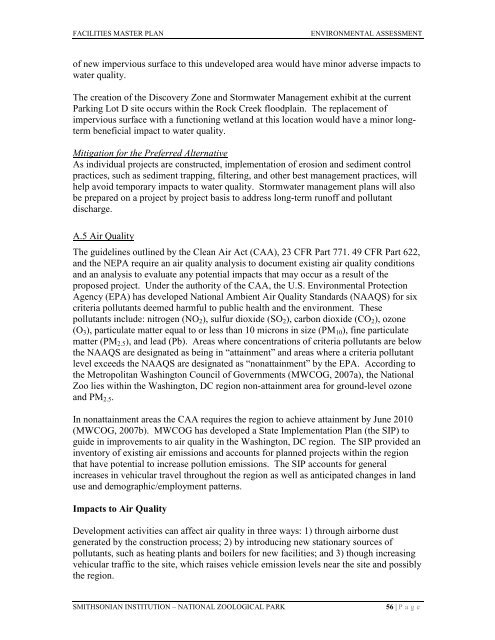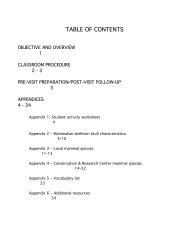facilities renewal master plan - National Zoo - Smithsonian Institution
facilities renewal master plan - National Zoo - Smithsonian Institution
facilities renewal master plan - National Zoo - Smithsonian Institution
Create successful ePaper yourself
Turn your PDF publications into a flip-book with our unique Google optimized e-Paper software.
FACILITIES MASTER PLAN ENVIRONMENTAL ASSESSMENT<br />
of new impervious surface to this undeveloped area would have minor adverse impacts to<br />
water quality.<br />
The creation of the Discovery Zone and Stormwater Management exhibit at the current<br />
Parking Lot D site occurs within the Rock Creek floodplain. The replacement of<br />
impervious surface with a functioning wetland at this location would have a minor longterm<br />
beneficial impact to water quality.<br />
Mitigation for the Preferred Alternative<br />
As individual projects are constructed, implementation of erosion and sediment control<br />
practices, such as sediment trapping, filtering, and other best management practices, will<br />
help avoid temporary impacts to water quality. Stormwater management <strong>plan</strong>s will also<br />
be prepared on a project by project basis to address long-term runoff and pollutant<br />
discharge.<br />
A.5 Air Quality<br />
The guidelines outlined by the Clean Air Act (CAA), 23 CFR Part 771. 49 CFR Part 622,<br />
and the NEPA require an air quality analysis to document existing air quality conditions<br />
and an analysis to evaluate any potential impacts that may occur as a result of the<br />
proposed project. Under the authority of the CAA, the U.S. Environmental Protection<br />
Agency (EPA) has developed <strong>National</strong> Ambient Air Quality Standards (NAAQS) for six<br />
criteria pollutants deemed harmful to public health and the environment. These<br />
pollutants include: nitrogen (NO2), sulfur dioxide (SO2), carbon dioxide (CO2), ozone<br />
(O3), particulate matter equal to or less than 10 microns in size (PM10), fine particulate<br />
matter (PM2.5), and lead (Pb). Areas where concentrations of criteria pollutants are below<br />
the NAAQS are designated as being in “attainment” and areas where a criteria pollutant<br />
level exceeds the NAAQS are designated as “nonattainment” by the EPA. According to<br />
the Metropolitan Washington Council of Governments (MWCOG, 2007a), the <strong>National</strong><br />
<strong>Zoo</strong> lies within the Washington, DC region non-attainment area for ground-level ozone<br />
and PM2.5.<br />
In nonattainment areas the CAA requires the region to achieve attainment by June 2010<br />
(MWCOG, 2007b). MWCOG has developed a State Implementation Plan (the SIP) to<br />
guide in improvements to air quality in the Washington, DC region. The SIP provided an<br />
inventory of existing air emissions and accounts for <strong>plan</strong>ned projects within the region<br />
that have potential to increase pollution emissions. The SIP accounts for general<br />
increases in vehicular travel throughout the region as well as anticipated changes in land<br />
use and demographic/employment patterns.<br />
Impacts to Air Quality<br />
Development activities can affect air quality in three ways: 1) through airborne dust<br />
generated by the construction process; 2) by introducing new stationary sources of<br />
pollutants, such as heating <strong>plan</strong>ts and boilers for new <strong>facilities</strong>; and 3) though increasing<br />
vehicular traffic to the site, which raises vehicle emission levels near the site and possibly<br />
the region.<br />
SMITHSONIAN INSTITUTION – NATIONAL ZOOLOGICAL PARK 56 | P a g e

















